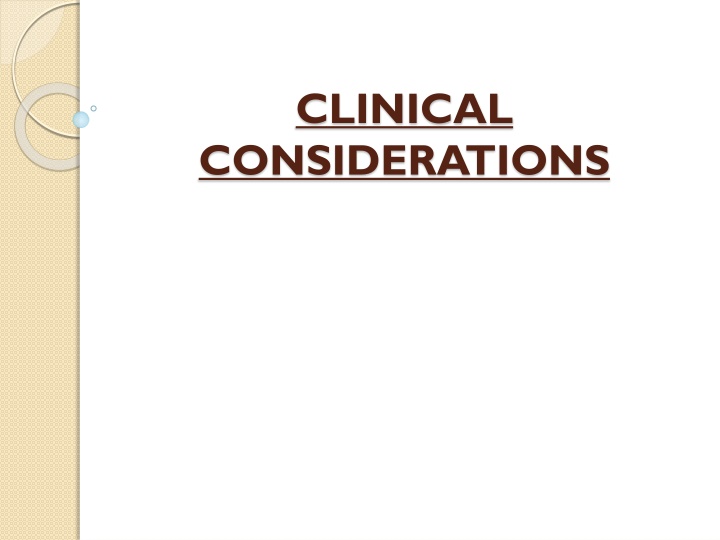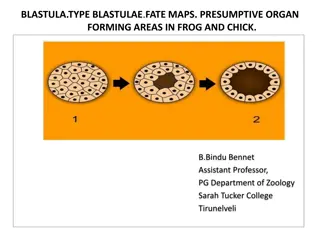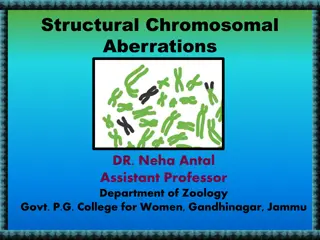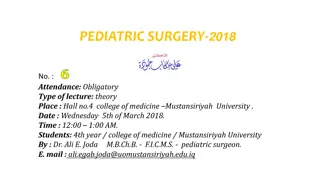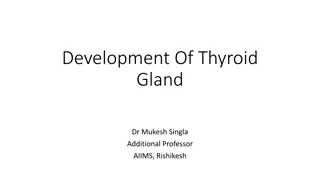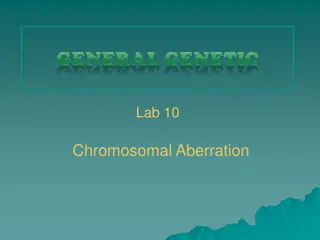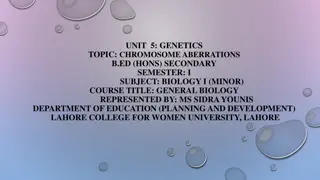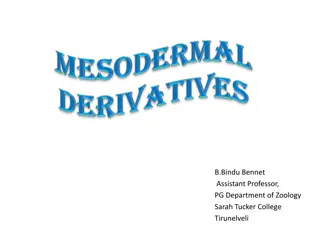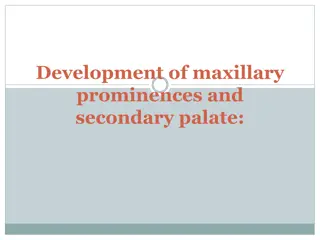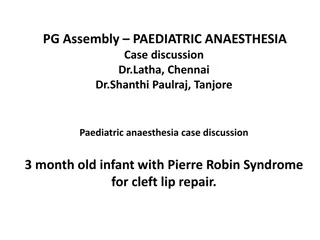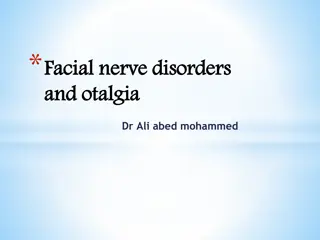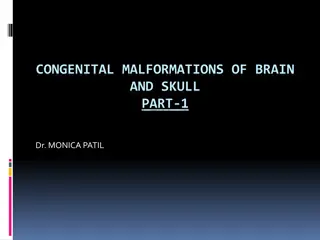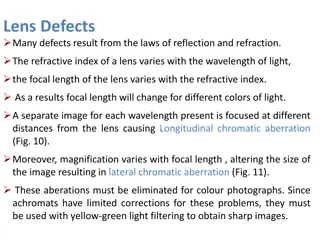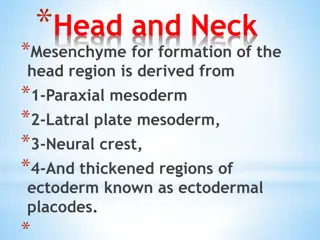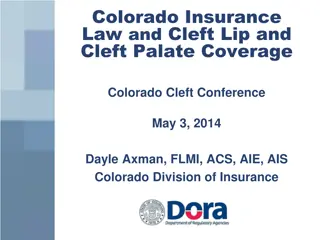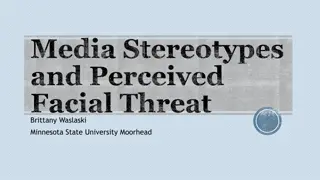Aberrations in Embryonic Facial Development and Cleft Malformations
Aberrations in embryonic facial development lead to a wide variety of defects, with primary and secondary palate development being most common. Facial clefts, influenced by genetic and environmental factors, present distinct types possibly involving deficient medial nasal prominences or underdevelopment of maxillary prominence. Various factors such as maternal epilepsy medication or smoking can impact clefting rates. Understanding the multifactorial etiology behind cleft cases is crucial, with some patients exhibiting clefts in both primary and secondary palates. The variability in clefts can range from bilateral to unilateral and complete to incomplete, showcasing the complexity of facial malformations in humans.
Download Presentation

Please find below an Image/Link to download the presentation.
The content on the website is provided AS IS for your information and personal use only. It may not be sold, licensed, or shared on other websites without obtaining consent from the author.If you encounter any issues during the download, it is possible that the publisher has removed the file from their server.
You are allowed to download the files provided on this website for personal or commercial use, subject to the condition that they are used lawfully. All files are the property of their respective owners.
The content on the website is provided AS IS for your information and personal use only. It may not be sold, licensed, or shared on other websites without obtaining consent from the author.
E N D
Presentation Transcript
CLINICAL CONSIDERATIONS
Aberrations in embryonic facial development lead to a wide variety of defects. Although any step may be impaired, defects of primary and secondary palate development are most common. There is evidence that other developmental defects may be even more common but they are not compatible with completion of intrauterine life .
Facial clefts: Most cases of clefts of the lip with or without associated cleft palate appear to form a group etiologically different from clefts involving only the secondary palate. For example, when more than one child in a family has facial clefts, the clefts are almost always found to belong only to one group. Some evidence now indicates
that there are two major etiologically and developmentally distinct types of cleft lips and palate. In the larger group, deficient medial nasal prominences appear to be the major developmental alteration, whereas in the smaller group the major developmental alteration appears to be underdevelopment of the maxillary prominence.
Increases in clefting rates have been associated with children born to epileptic mothers undergoing phenytoin (Dilantin) therapy and to mothers who smoke cigarettes; in the latter case the embryonic effects are thought to result from hypoxia. When pregnant mice are exposed to hypoxia, the portion of the olfactory placode undergoing morphogenetic movements breaks down, and this is associated with underdevelopment of the lateral nasal prominence.
Combination of developmental alterations (e.g., placodal breakdown associated with medial nasal prominence deficiency) may relate to the multifactorial etiology thought to be responsible for many human cleft cases. About two thirds of patients with clefts of the primary palate also have clefts of the secondary palate. Excessive separation of jaw segments as a result of the primary palate cleft prevents the palatal shelves from contacting after elevation. The degree of clefting is highly variable. Clefts may be either bilateral or unilateral and complete or incomplete.
Degrees of mesenchyme in the facial prominences. Some of the variations may represent different initiating events. Clefts involving only the secondary palate (cleft palate, constitute, after clefts involving the primary palate, the second most frequent facial malformation in humans.
Usually some chemical agents retard or prevent shelf elevation. In other cases, however, it is shelf growth that is retarded so that, although elevation occurs, the shelves are too small to make contact. There is also the failure of the epithelial seam or failure of it to be replaced by mesenchyme occurs after the application of some environmental agents.
Cleft formation could then result from rupture of the persisting seam, which would not have sufficient strength to prevent such rupture indefinitely. Less frequently, other types of facial clefting are observed. In most instances they can be explained by failure of fusion or merging between facial prominences of reduced size. Examples include failure of merging and fusion between the maxillary prominence and the lateral nasal prominence, leading to oblique facial clefts, or failure of merging of the maxillary prominence and mandibular arch, leading to lateral facial clefts (macrostomia).
Many of the variations in the position or degree of these rare facial clefts may depend on the timing or position of arrest of growth of the maxillary prominence that normally merges and fuses with adjacent structures. Other rare facial malformations (including oblique facial clefts) may also result from abnormal pressures or fusions with folds in the fetal (e.g., amniotic) membranes.
Also new evidence regarding the apparent role of epithelial mesenchymal interactions via the mesenchymal cell process meshwork (CPM) may help to explain the frequent association between facial abnormalities, especially clefts, and limb defects. Genetic and/or environmental influences on this inter- action might well affect both areas in the same individual.
Hemifacial microsomia: The term hemifacial microsomia is used to describe malformations involving underdevelopment and other abnormalities of the temporomandibular joint, the external and middle ear, and other structures in this region, such as the parotid gland and muscles of mastication. The associated malformations of the vertebrae and clefts of the lip and/ or palate. The combination with vertebral anomalies is often considered to denote a distinct etiologic syndrome (oculoau- riculovertebral syndrome, etc.).
As a group these malformations Labial pits: Small pits may persist on either side of the midline of the lower lip. They are caused by the failure of the embryonic labial pits to disappear
Lingual anomalies: Median rhomboid glossitis, an innocuous, red, rhomboidal smooth zone of the tongue in the midline in front of the foramen cecum, is considered the result of persistence of the tuberculum impar. Lack of fusion between the two lateral lingual prominences may produce a bifid tongue. Thyroid tissue may be present in the base of the tongue.
Developmental cysts: Epithelial rests in lines of union, of facial or oral prominences or from epithelial organs, (e.g., vestigial nasopalatine ducts) may give rise to cysts lined with epithelium. Branchial cleft (cervical) cysts or fistulas may arise from the rests of epithelium in the visceral arch area. They usually are laterally disposed on the neck. Thyroglossal duct cysts may occur at any place along the course of the duct, usually at or near the midline.
Cysts may arise from epithelial rests after the fusion of medial, maxillary, and lateral nasal prominences. They are called globulomaxillary cysts and are lined with pseudostratified columnar epithelium and squamous epithelium. They may, however, develop as primordial cysts from a supernumerary tooth germ.
Anterior palatine cysts are situated in the midline of the maxillary alveolar prominence may be from remnants of the fusion of two prominences, they may be primordial cysts of odontogenic origin.
Nasolabial cysts, originating in the base of the wing of the nose and bulging into the nasal and oral vestibule and the root of the upper lip, sometimes causing a flat depression on the anterior surface of the alveolar prominence, are also explained as originating from epithelial remnants in the cleft-lip line. It is, however, more probable that they derive from excessive epithelial proliferations that normally, for some time in embryonic life, plug the nostrils.
It is also possible that they are retention cysts of vestibular nasal glands or that they develop from the epithelium of the nasolacrimal duct. The malformations in the development of head may indicate the defective formations in the heart as the spiral septum.
